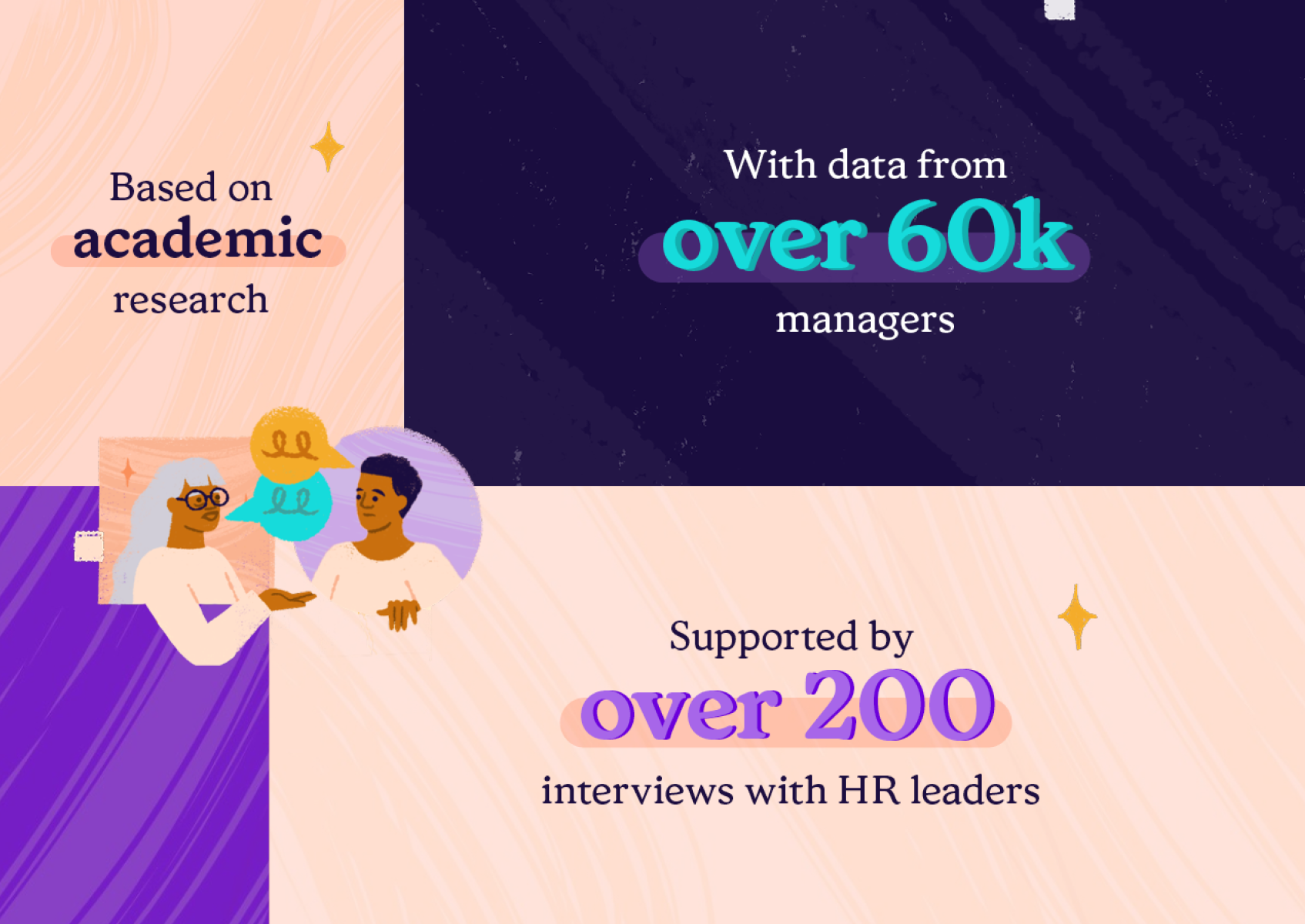Building the Manager Effectiveness Indicator with insights from 60,000+ managers
Your company’s success depends on the effectiveness of your managers.
At 15Five, we believe that every HR leader should have a way easily measure, analyze, and act with confidence on the data that connects their performance management programs to business impact — which is why we created the HR Outcomes Dashboard. A key driver of that data is manager effectiveness. In this article, we will highlight some of the research and development process that went into building the Manager Effectiveness Indicator (MEI) to help our customers start measuring and improving their managerial effectiveness in service of impacting their organizational performance. We compiled our findings in a research report to peel back the curtain into our research and development of the MEI.
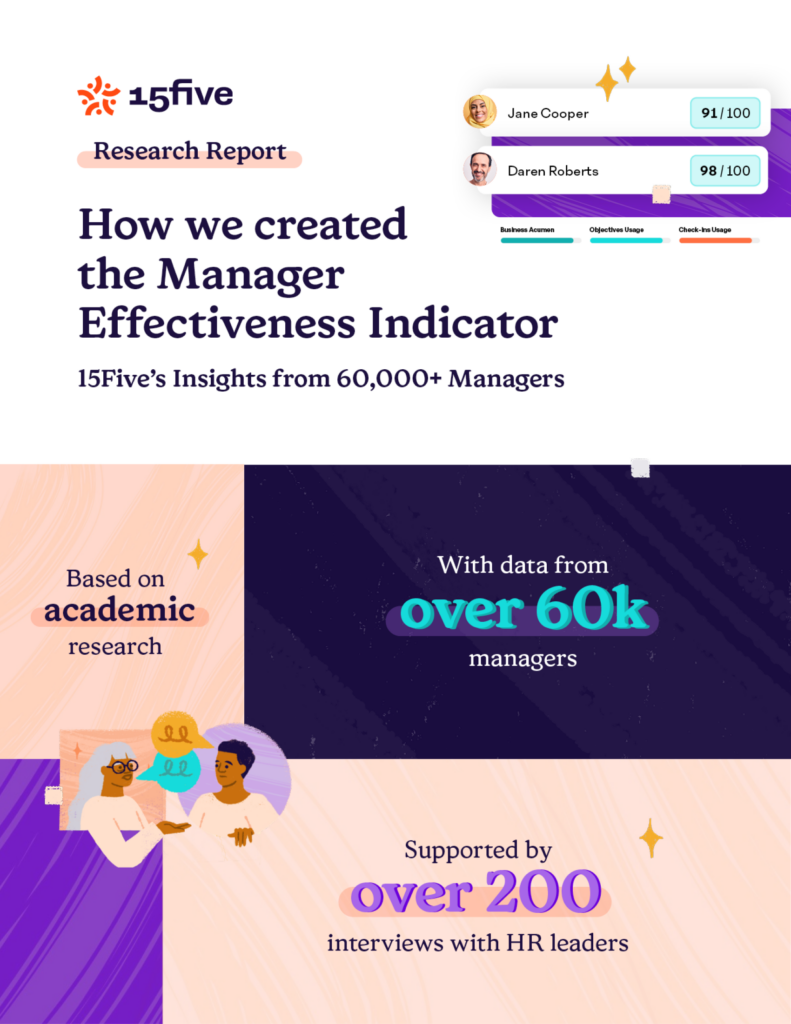
Why Manager Effectiveness Matters
The best HR leaders know that HR needs to shift from an administrative-only position to having a more strategic impact on their organization. Doing “HR work” is no longer good enough if it isn’t increasing employee engagement, maximizing performance, and decreasing regrettable turnover.
Unsurprisingly, this is because engagement, performance, and retention have clear connections to an organization’s business results. In fact, according to Gartner, high employee engagement correlates with higher average revenue growth, net profit margin, customer satisfaction and earnings per share. With these areas of focus in mind, the leading thinkers in HR are recognizing that effective managers are the highest leverage way to drive these outcomes. Extensive research, including countless conversations with top HR leaders over the past year, has shown that increasing manager effectiveness is consistently prioritized as a primary focus to drive business results and an organization’s most important strategic outcomes.
While manager effectiveness is top of mind for so many HR leaders, understanding the current state of manager effectiveness is a much more difficult task. The role of a manager is extremely varied and often disparate – from helping employees create and achieve goals, to providing feedback and coaching, not to mention managing their own work as individual contributors. The difficulty of defining relevant metrics to represent these responsibilities, compiling that data, and leveraging it on a frequent basis to meet business demands explains why few organizations are confident in their quantifiable measures of manager effectiveness. As an alternative, many organizations look to data from performance reviews and engagement surveys to understand how their managers are doing. While these provide relevant insights, they’re inherently retrospective, rather than forward-looking in nature, and run the risk of becoming stale between review cycles. Often HR leaders are left to rely on anecdotes or reports once a situation has escalated. This creates distraction and fuels disengagement among managers, leading to attention being placed on addressing day to day incidents and away from key strategic initiatives that will serve the business in the long run.
HR needs a framework to evaluate manager effectiveness on a frequent basis and in a holistic way in order to consistently drive the results that their organizations prioritize. Aligning this framework to culture and expectations for managers, with strategies to implement in the organization, will help to unlock greater engagement, performance and retention.
Measuring effectiveness has always been challenging.
The resources needed for ongoing data gathering, synthesizing, and reporting
The abundance of data required to comprehensively represent manager effectiveness poses a daunting task for HR departments as they work to compile the data and prioritize the analysis of this data against other urgent demands. Gathering multiple data points, such as performance metrics, employee feedback, and team outcomes, in a way that provides insights on areas that need improvement at a frequency that can support the pace of business changes, is a significant hurdle.
Weighing objective and subjective data while avoid bias
Determining the most suitable combination of objective and subjective data points is a crucial consideration. Quantitative metrics offer concrete insights that can be gathered more frequently, but they often fail to capture essential qualitative aspects of effective management from key perspectives like direct reports and management. Including subjective data from a review cycle or survey can provide valuable insight on key areas like leadership style, communication skills, and employee morale. While data from surveys or reviews is essential, many organizations face challenges with this data being recent as it is dependent on running a survey or review cycle – practices that often occur on an annual or biannual cadence. Supplementing survey and review data with quantitative metrics that reflect the regular behaviors of a manager is essential to gain a holistic understanding of manager effectiveness.
Unclear managerial expectations
Most organizations do not have clear agreements or expectations for what it takes to be an effective people manager. This leads to managers within an organization often demonstrating different variations of management behaviors and practices typically based on their experiences or personal preferences. If you ask one hundred managers what it means to be a manager, you will receive one hundred different answers. Very few organizations define what it means to be a manager or leader within their organization, and many blend playing and coaching. Since many managers only have one or two direct reports, they need to make a substantial impact as individual contributors as well.
How we have overcome these challenges
15five is on a mission to help HR leaders drive results through human-centered leadership and management. We have been committed to addressing these challenges head-on in order to help organizations enhance managerial effectiveness, and in turn improve employee engagement and performance, reduce regrettable turnover, and drive overall organizational success.
This report aims to explore practical solutions and best practices to overcome these obstacles and establish a comprehensive framework for measuring manager effectiveness in a data-driven and timely manner.
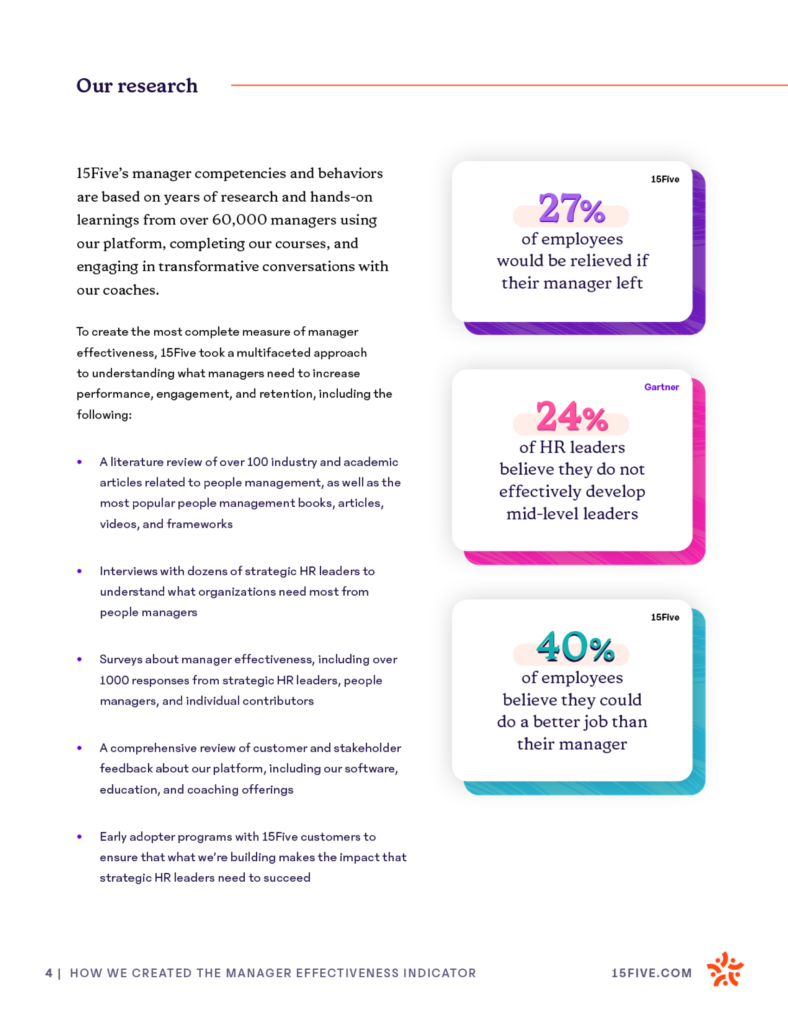
Our research
15Five’s manager competencies and behaviors are based on years of research and hands-on learnings from over 60,000 managers using our platform, completing our courses, and engaging in transformative conversations with our coaches.
In addition to a comprehensive review of customer and market feedback about our platform, including our software, education, and coaching offerings, our research and development teams conducted a literature review of over 100 industry and academic articles related to people management, as well as the most popular people management books, articles, videos, and frameworks and conducted validated surveys, which included over 1000 responses from strategic HR leaders, people managers, and individual contributors.
15Five took a multifaceted approach to understanding what managers need to increase performance, engagement, and retention, and we are proud to introduce the Manager Effectiveness Indicator.
The Manager Effectiveness Indicator
The Manager Effectiveness Indicator (MEI) from 15FIve is the easiest way to quantify the effectiveness of your managers with a customizable, science-backed metric and see how it impacts employee engagement, retention, and performance.
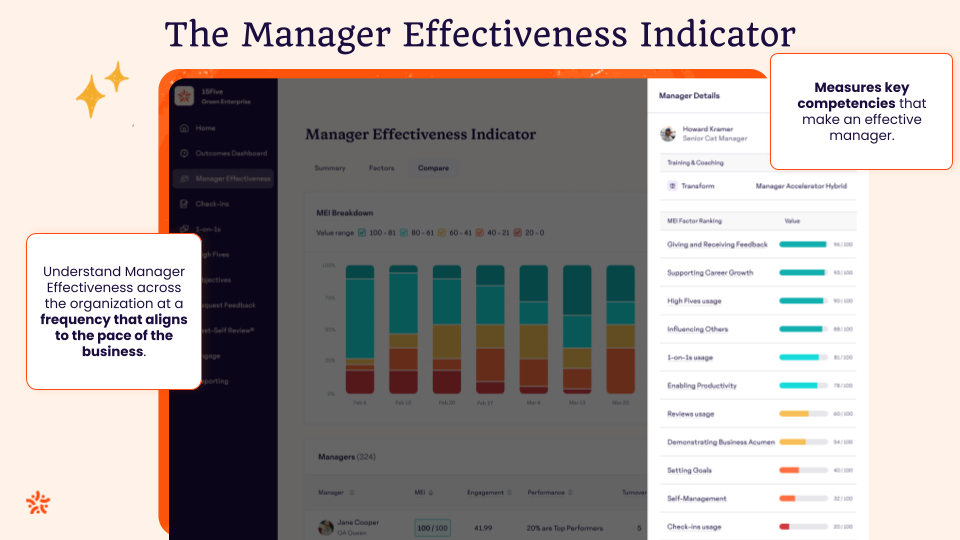
We believe that effective people management is a practice, requiring consistent demonstration of the right behaviors that drive the outcomes of performance, engagement, and retention. It’s not something that managers learn in a single manager orientation session or even gain with years of experience alone.
Now you can easily see which managers are excelling and which managers need support in specific areas, and take action before issues impact the organization. 15Five’s approach is unique because the MEI assesses objective (behavioral) and observational (assessment) data on managers to give a complete picture of their effectiveness.
15Five’s MEI offers a holistic view of how effective your managers are, how they are impacting bottom-line metrics, and what you can do to help them improve.
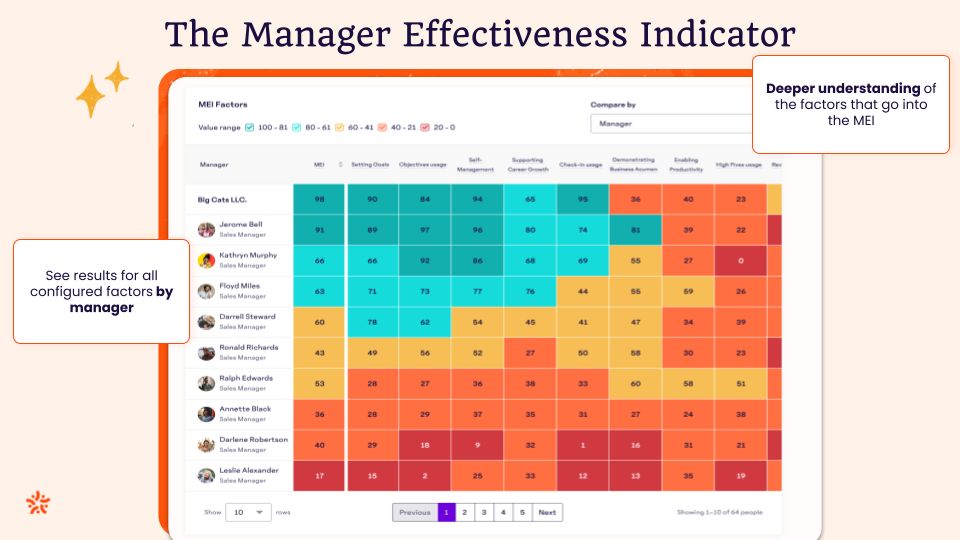
Finally understand each manager’s impact
- We know employees quit their managers, but until now it has been hard to quantify how to measure a manager’s effectiveness. Now you can have a single metric to assess each individual manager as well as the company-wide aggregate.
Find balance with customizable weighting and inputs
- Effectiveness is both objective and subjective. Measure the competencies of an effective manager through a combination of objective behaviors and 360° feedback. Filter by department, team, or individual leader
Understand who your top managers are and who needs to be developed.
- Filter and sort to uncover how every manager or department leader is impacting engagement, retention, and performance.
- Compare by Groups:
- Compare the data about all four outcomes across other group types at your organization (departments, teams, etc.)
- Compare by Managers:
- Go a level deeper with your data analysis to learn about the managers leading the people across your org. By identifying managers who need support, you can lean into improving these outcomes across their teams.
